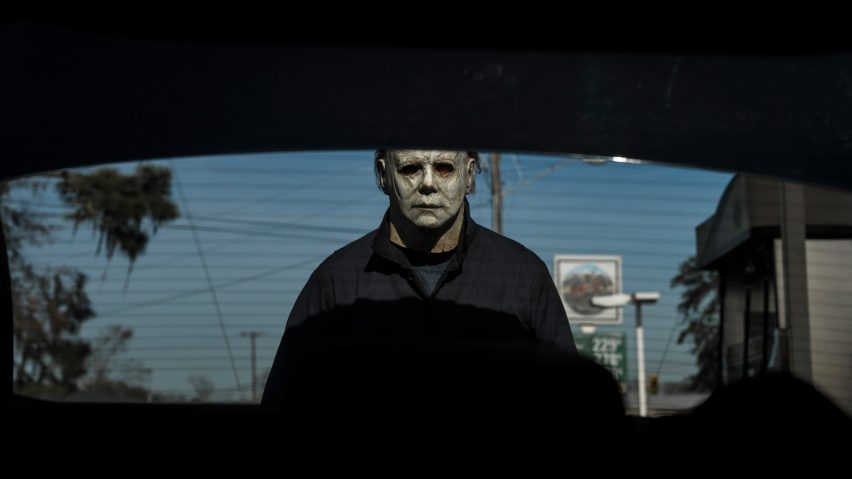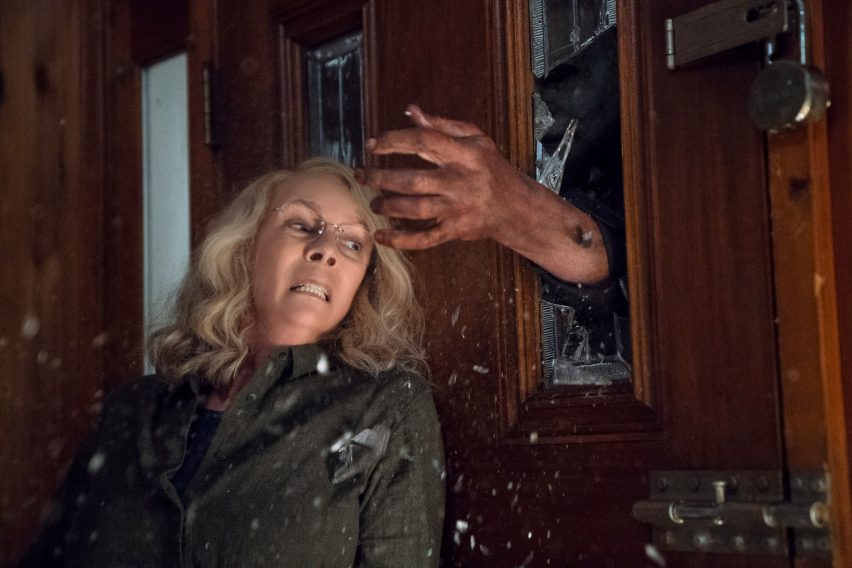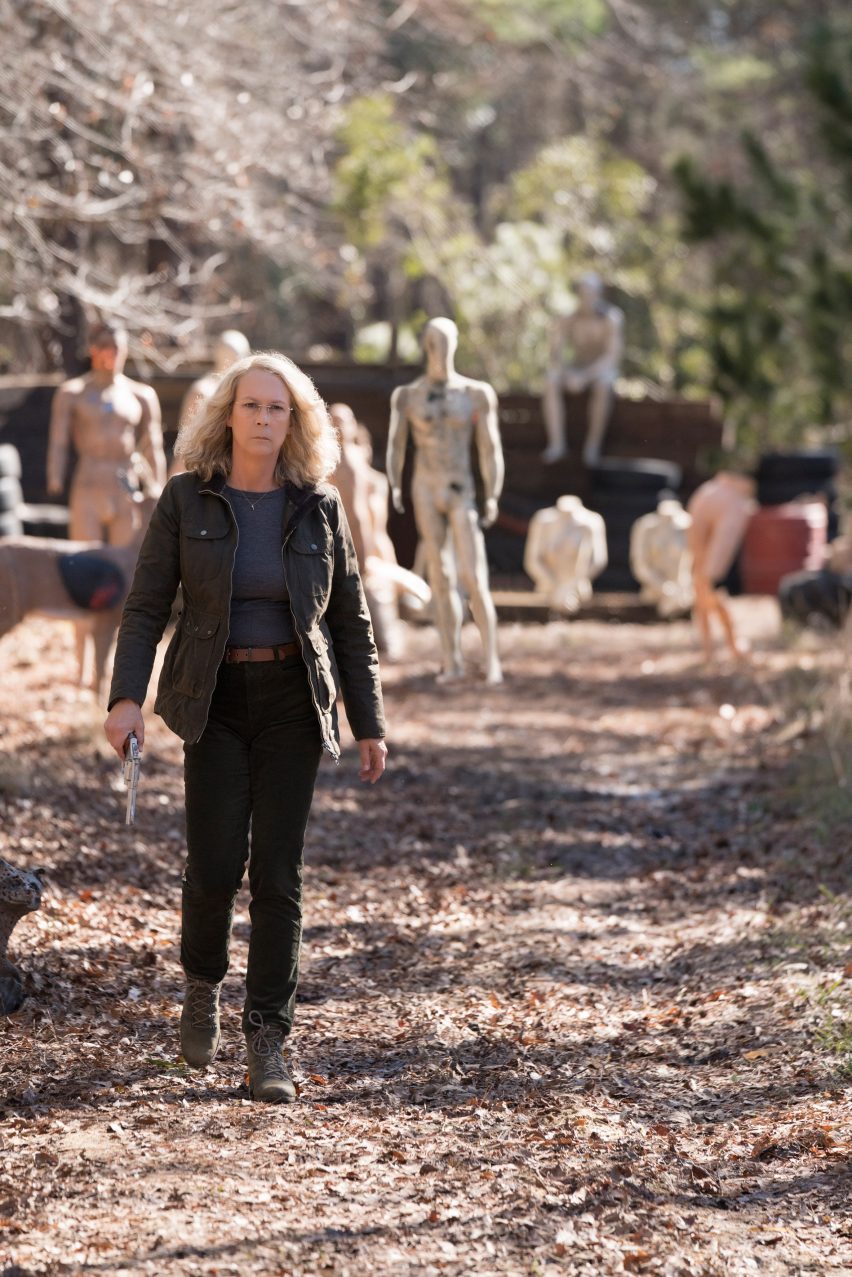
Halloween movie designer's biggest fear was "keeping all of our pumpkins fresh"
For all the on-screen blood and gore of horror film Halloween, the scariest part behind the scenes was perishing pumpkins, says the set dresser for the franchise's latest offering.
Slasher movie specialist Missy Berent Ricker said her biggest challenge for this year's Halloween movie was keeping the set's festive decor alive in the cold.
This included the hundreds of pumpkins that were trucked in to the South Carolina location, and carved into jack-o'-lanterns that decorated the porches across the fictional town of Haddonfield.
"Everyday we had to throwaway pumpkins, they were perishing so quickly," Ricker told Dezeen. "We were so scared that we weren't going to have any by the end of filming."
But the team came up with a solution to preserving the orange vegetables, which involved submerging them in bleach baths.

This was one of many tricks that Ricker used while filming the movie – the eleventh in the franchise, which is intended as a direct sequel to the 1978 original.
Set 40 years after the first, on 31 October 2018, the plot follows character Laurie Strode as she awaits masked madman Michael Myers' return to the town, and his killing spree that ensues.
"We tried to stay true to that homey, low-budget kind of vibe," Ricker said. "For the most part this was a really classic horror film, like the original."
While filming the special effects, Ricker's strategies included using a set of velcro couch covers that could be removed and replaced in between takes, after being splattered with "blood".

The set decorator has also worked on thrillers including The Strangers and Netflix series The Sinner, so has devised a range of similar techniques to deal with the stunts and make-up.
"Doing a lot of films in the horror genre, you do start learning the kinds of challenges that you're going to have on a set," Ricker said.
"There are certain practical things you need to be aware of when doing this kind of movies," she continued. "There's often action and special effects, which can affect your sets."
Read on for an edited transcript of our interview with Missy Berent Ricker:
Eleanor Gibson: What was your role on the film?
Missy Berent Ricker: I was the set decorator on Halloween 2018. As the set decorator, I'm part of the art department team working under our production designer, Richard Wright, who had the overall vision along with the writers and director for the look of the film and the mood of the film.
I took all of my direction from him as far as the types of things that we would dress onto the set and the mood the we were trying to convey.
Eleanor Gibson: And what was the mood?
Missy Berent Ricker: We wanted to make the new version an extension of the original, as far as the characters, and their spaces and history. With Laurie in particular, her farmhouse, we tried to brainstorm about what her life has been like for the last 40 years.
We thought that there was probably a point in her life where she did try to have some kind of normalcy in her world, for her and for Karen her daughter. There may have been a time where she decorated or had coordinated window treatments and furniture, and wallpaper.
But as the years went on and as her obsession grew, what she had tried to create as a family home, became more of her fortified, very guarded area. We had layers.
Eleanor Gibson: How do you go about bringing a scary, eery feel to normal environments?
Missy Berent Ricker: With Laurie, the things that were evidenced in her house lend themselves to that. You're looking at this floral print couch but then you see a gun cleaning kit on the kitchen island, or you see bars on the windows. Her home in particular we had a little bit of the survivalist kind mentality going on – that becomes eery.
In some ways, just creating a space that has little hints of things that are dark can be found in the movie as well. For example, one of my favourite sets is Julien's bedroom – the little boy. As a set decorator, of course I'm talking about the set dressing elements, and one of the things I love from that set is the wallpaper by Paperboy Wallpaper.
Little hints of things that are dark can be found in the movie
Our designer immediately was drawn to some of the darker tones. That particular wallpaper was a dark olive colour and it had the gold point and little robotic animals. Even that was a little darker in theme and in colour scheme then you might usually find in an eight year old's bedroom.
Then we had handmade paper lanterns from Washington state. You have this kind of childlike, playful image on the lantern projected on this very dark wallpaper. The lighting and things like that certainly also add to the eery quality that sets the mood and sets the tone for you as well.
Eleanor Gibson: It's almost like interior design, having the opportunity to design for these characters?
Missy Berent Ricker: Absolutely and that's what I love about set decoration. We're not always creating something beautiful, we're trying to create an environment that helps tell the story. There are many ways to tell the story, you can do it through the dialogue, through the action. But for us we have the opportunity to help tell the story through the character's environments. And those are the sets that I really get into.
Another set that I really loved was Smith's Grove Sanitarium – the institution where Michael was housed. You don't see a lot of it on screen, just because some of the lighting is bright and blown out in the individual cells. But we actually went to great lengths to dress the individual cells with sort of obsessive compulsive things that some of these mental patients would have had.
There was one room that was all origami, and others where some of the patients had torn paper out of books and almost wallpapered the interior of their cells.
We really tried to do some very homegrown, artsy decorations
My buyer and I researched prison art and things in mental institutions to try to bring those layers to the screen. Even if you don't see it on screen in the finished cut of the movie, those things help the actor get into character. Even if we don't necessarily see every detail on screen it is part of the storytelling in that way.
Eleanor Gibson: Did you have any other reference points?
Missy Berent Ricker: Obviously Halloween and Halloween decorations. We wanted to keep a lot of the decorations organic and less commercial, so you see some orange lights, and some light-up pumpkin-y things and blow-up inflatable decorations. But for the most part we really tried to do some very homegrown, artsy decorations.
There's one scene where we did a silhouette plywood cut-out of two witches stirring a cauldron, painted black and we had a green light source behind it. And others where we had orange lanterns, like the china ball lanterns in the tree, and we had painted little jack-o'-lantern faces on them.
For another porch, we had taken milk jugs and put a light source inside of the milk jugs, and little eyes and ghosty mouths on them. They were illuminated and looked like little glowing ghosts.
And then of course all of the pumpkins and skeletons, we had a ton of skeletons on the show. We did a lot with hay bales, skeletons and pumpkins. Those were in our kit if you will.
We did a lot with hay bales, skeletons and pumpkins
Eleanor Gibson: You're behind the sets of some of the scariest series and films, like The Strangers, The Sinner. Do you seek those for a reason?
Missy Berent Ricker: It's funny, I have done quite a bit of hard, thriller, genre shows now. They're really fun.
There are certain practical things you need to be aware of when doing this kind of movies. There's often action and special effects, which can affect your sets.
I know to ask certain questions about how the action is going to tie into our set. For example, if someone's going to crash into a coffee table, I may need multiples of that coffee table. Or if there is going to be blood splatter on a couch, we need to either plan to have multiples on the couch, although we cannot always afford that. So maybe we get creative and we have something that can be changed out each time with the blood.
In Halloween we had a scene where Michael goes into the house with all the jack-o'-lanterns on the porch and surprises a lady at the window.
As he attacks her, there is an opportunity for blood to splatter on the back of the couch. It was a camel-backed couch and we had several upholstered backs with the same brocade fabric that we could switch out. These were just velcroed onto the back of the couch, so that for each take if the back panel got bloody, we could switch it out for another.
Doing a lot of films in the horror genre, you do start learning the kinds of challenges that you're going to have on a set.
We tried to stay true to that homey, low-budget kind of vibe
Eleanor Gibson: Were the any developments or significant changes to the set since the last Halloween film?
Missy Berent Ricker: We tried to stay true to that homey, low-budget kind of vibe. There were amazing special effects in the movie and amazing special effects makeup but for the most part this was a really classic horror film, like the original.
It doesn't rely on much – we didn't see much of the kills on screen, it doesn't even rely as much on seeing someone bludgeoned to death, as it does on the horror of that discovery. For that reason it really does feel like an extension of the original in the very classic sense that it appeals to you on a psychological.
You're experiencing the terror of Michael being on the loose as he's kind of hunting, picking his way through town and it's that scary thing: is he going to jump from around the corner? Sometimes those kind of scares can be more terrifying than seeing something super gory on screen.
Eleanor Gibson: Were there any challenges in the project?
Missy Berent Ricker: The challenge of keeping all of our pumpkins fresh. That actually was a very practical challenge because it got very cold here in South Carolina once we started filming, and pumpkin season is usually a fall harvest. So there were no more pumpkins even in the fields, and if they were they were starting to rot.
We had to go further north to get some that were still in the fields where they were still preserved. We trucked in hundreds and hundreds of pumpkins from North Carolina. We knew that they wouldn't last for two months of filming.
Our set dressers did a lot of research on the internet and found that there were different recipes involving bleach and bleach baths where you could dip the pumpkins, and that would help to preserve the life of the pumpkin.
Everyday we had to throwaway pumpkins, they were perishing so quickly
We had these elaborate rows of tables with pumpkins in our warehouse and vats of bleach baths that they would dip them in daily.
Everyday we had to throwaway pumpkins, they were perishing so quickly. We were so scared that we weren't going to have any but the end of filming. When they would perish, our set dressers would take them out by the warehouse and just chuck them in the woods.
One of our set dressers went by there recently and sent me a picture – we have a pumpkin orchard starting behind the warehouse now, there are vines everywhere. The mutated, bleach-infested pumpkins are now growing. I can't wait to see what these bleach bath pumpkins are going to grow into.